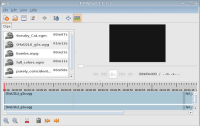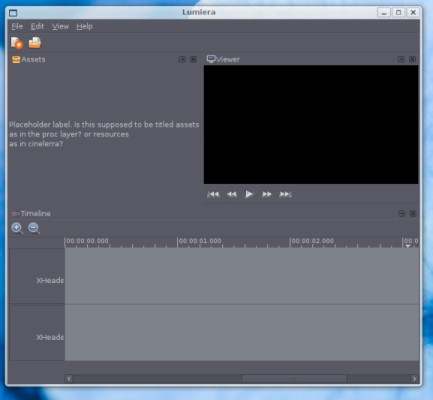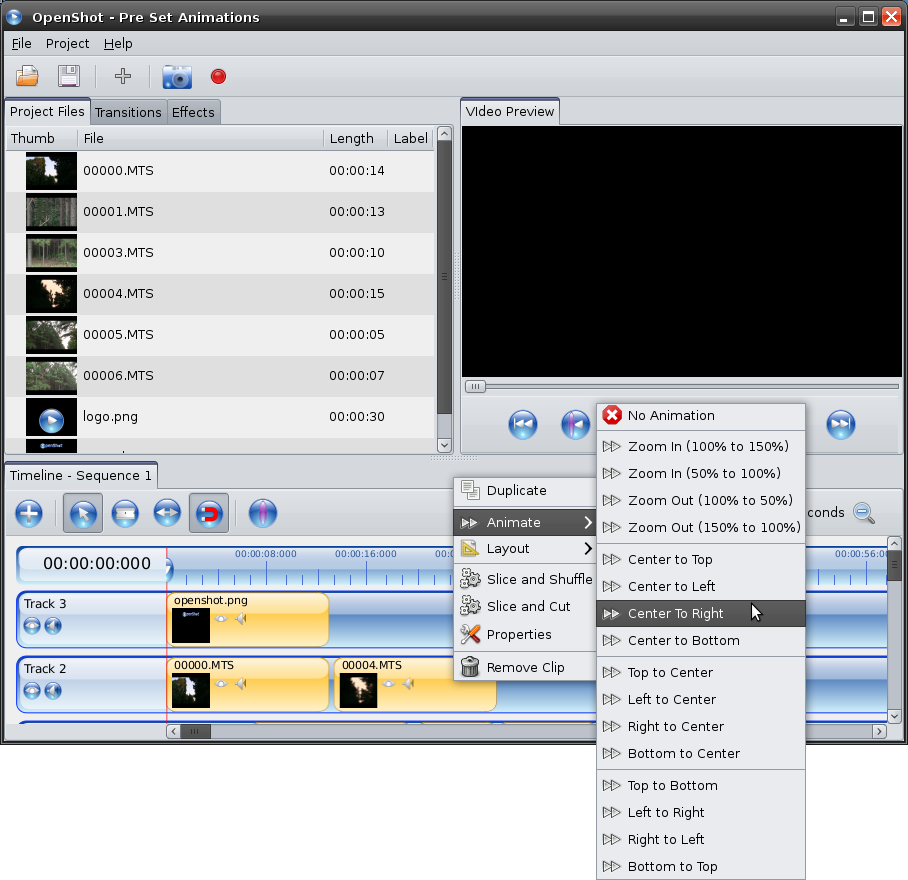The Open Source world needs good Non Linear Editing software(cross platform). So far most projects have died in the attempt, but by showing some interest and helping out this might change.
Blender:
The sequence editor in blender.org, is the only working cross platform solution atm.
On editing AVC and HDV in Blender: http://www.openfilmmaking.com/blenderavc/
Blender sequence editor video tutorials:
http://www.totallyblended.com/tut19page.html
http://www.totallyblended.com/tut20page.html
http://www.totallyblended.com/tut21page.html
Linux and Win(Mac delayed):
VLMC: http://vlmc.org/ no releases yet.
Based on MLT, which isn't cross platform only Linux and Mac, but both programs are included in liveCDs:
Kdenlive: http://kdenlive.org/ - is KDE actually working on Windows? http://windows.kde.org/
Open Shot: http://www.openshotvideo.com/
Based on Gstreamer, which means Linux, but experimental win build is out:
Pitivi: http://www.pitivi.org/
Lumiera: http://lumiera.org/ Linux and maybe Mac?
No longer updated:
Avisynth Studio: http://teejee2008.wordpress.com/avisynth-studio/ Win
Saya: http://saya-videoeditor.blogspot.com/ Cross platform
Open Movie Editor: http://www.openmovieeditor.org/ Linux
+ Reply to Thread
Results 1 to 30 of 42
-
Last edited by tin2tin; 11th Feb 2010 at 12:17.
-
@ Admin:
The post above was moved into the Editing forum(from general forum), here it hasn't gathered much interest(if any?).
Maybe the programming forum would be a better place for this? -
Another project to follow: PiTiVi
(Not cross platform to my knowlege)
GSOC additions:
Brandon Lewis.
Sarath Lakshman -
The people that start these projects don't understand the problem. The resources required are huge and patents are a mine field.
Recommends: Kiva.org - Loans that change lives.
http://www.kiva.org/about -
All I can say is that I'm greatful that people are trying. Most software areas have open source alternatives, but not NLE video editing.
If there is something you have a deeper understanding of and you feel you can help them out - why don't you?
Brandon Lewis' addition to PiTiVi is beginning to look nice:

-
Lumiera: Updated 19/06/08

Done
[s:1326db1404]Tiled Windows
One Window can be tiled (horizontally/vertically) giving areas where screen elements can be placed (see blender)
Multiple windows
Can open multiple windows on one head and (optionally) tile them as above
-- ct 2008-02-07 20:42:54
My personal preference would be to produce the GUI in C++ with Gtkmm. Gnome is the most popular desktop for Linux, and GTK now has good support both for Win32, Mac and KDE (except that GTK on Mac still needs X11, probably for some more time)
This sketch shows the GTK docking system, as seen in Anjuta (and to some extent in Inkscape). The GTK docking system is like a tiling window manager in a window. This allows the layout of panels to be totally rearranged, or even detached into floating windows. These floating panels can be stuck together in a single child window. This would be a perfect way to span the workflow across 2 screens. For me, it's this feature that most attracts me to GTK. [/s:1326db1404] -
Apparently there is a Blender build out now which supports avisynth in the Sequence Editor. You can find it here!
And using Avisynth to import AVC in Blender here!
Spamagnet:More Info here.This is for the Sequence Editor. AviSynth is a frame server tool which allows you to process video on the fly. For example, let's say you have an HDV or AVC camcorder which records 24p, but encodes it as 60i. You might be able to pull this video into Blender directly, but there is no way to filter it ("telecide") to get the nice clean 24 fps video stream. You then have two options:
Process and transcode the whole video to an intermediate format. In order to avoid quality degradation, you'd want to use lossless compression, so your hard disk usage will be huge.
Create an AviSynth script which processes/transcodes the video on the fly.
Basically, AviSynth lets you trade CPU for hard disk space. (The CPU load issue can be addressed by using the new proxy feature in Blender.)
Even better, the creation of AviSynth scripts (and proxies) can be automated. I am working on a project to handle this for AVC video; I'll post details when I get it to a usable state. -
Glad to see some interest! The Blender/AVC/AviSynth approach works quite nicely, though (at the moment) it's only appropriate for those who aren't afraid of a command line. If anyone is interested, I'd love to have some more input (Shameless plug for project home page: BlenderAVC).Originally Posted by tin2tin
The same approach can be used for HDV, by the way. -
3 new video tutorials on NLE editing in the Blender Sequence editor on TotallyBlended.com/:
http://www.totallyblended.com/tut19page.html
http://www.totallyblended.com/tut20page.html
http://www.totallyblended.com/tut21page.html -
Brandon Lewis' mock-ups for PiTiVi looks nice: http://pitivi.org/wiki/UI_Design
-
Wow take a look at these Kdenlive tutorials: http://kdenlive.org/tutorial
It looks like they succeded in making an useable clean NLE for Linux. It's coded in KDE4 which apparently can be compiled for Windows. At least that's stated on the KDE homepage. But there's no info on windows builds. Or if the Kdenlive 0.7 is included on any Linux Live CD's yet for us windooozer people. -
the problem is that NLE's are extremely difficult to code and the open source community is for the most part composed of hobbiests, who may not have the time or the skill to code such applications. even commercial NLE's have bugs and limitations and those projects have programmers that are paid to dedicate their time and experience to coding the app, so what chance does a project composed of hobbiests of varying programming experience stand?Originally Posted by tin2tin
now don't get me wrong, i am not in any way opposed to open source software, but i am realistic about it, the quality of linux distros varies greatly from atrocious to exceptional, project looking glass has gone absolutely nowhere since being released to the open source community and even the world's first open source cpu, the ultra sparc T1 and T2 whose design sun has donated to the open source community, with full specs and sdk's has not taken off.
how great would it be if some small firm took sun's design and made cheap ultra sparc T2 based cpu's that used the x86 instruction set and gave both intel and amd nightmares? -
Kdenlive video editor(for Windows and Intel MacOsX) on Live DVD or USB:
Get it here!Live demonstration on DVD or USB-storage
Sat, 12/20/2008 - 10:19 by jmpoure
This Live demonstration is a complete Debian GNU/Linux system on DVD or USB mass-storage, which boots and offers your a selection of the best multimedia softwares ... without the need to install to hard disc.
Unless you choose to resize your hard disc or decide to install GNU/Linux, it will not modify your operating system and will execute in memory only. After shuting down your computer, your old operating system is back. See boot screenshots.
If you choose the USB mass-storage flavour, it will execute as fast as an installed GNU/Linux system and allow complex video editing. The live demonstration is intended for Windows and Intel MacOsX users, who may be looking for a free software solution. -
http://www.openshotvideo.com/ is making great progress in a very friendly atmosphere. It's a MLT based Linux NLE.
Right now you can help out by translating it to your language.
It's very easy to get started:
First you need to get a https://launchpad.net/ profile and add your prefered language.
Then open https://translations.launchpad.net/openshot and start translating if your language hasn't been translated yet.

-
Very good point and a real issue, I agree. However, I'm very excited to say that I believe there's an easy way out!Originally Posted by deadrats
Let's first start off by reviewing the characteristics (give or take a few) of a good basic NLE:
- Media handling:
strong stable support for most popular media types
automatic clip creation in the case of DV AVI (from DATECODE timestamps)
strong support for filters - media processing, effects, etc.
rendering format supported by most encoders and other media applications
frame-level accuracy through-out
GUI:
keyboard shortcuts for common operations
ability to cut video clips
ability to add still clips
clips are automatically assigned customisable default names
clips are graphically identified by thumbnail icons of their content
clips can be trimmed, split, copied, pasted etc.
ability to hierarchically manage clip collections
realtime preview of individual clips
graphical timeline with clip drag-and-drop support
clips on timeline are shown with their thumbnail icons and text names
ability to add configurable transitions
optional: transitions shown on separate track for ease-of-use
ability to add configurable in-line text (titles, credits etc.)
ability to add configurable inlay text (captions, subtitles etc.)
optional: inlay text shown on separate track for ease-of-use
ability to add video effects to selected clips
optional: effects shown on separate track for ease-of-use
ability to add audio effects such as volume adjustment, mute etc. to selected clips
optional: audio can be rolled down to separate track for ease-of-use
additional audio track supporting same audio effects as above
timeline content can be edited (trim, split, delete, paste etc.) independently of original clips
fast keyboard timeline navigation - jumpt to next/previous item etc.
timeline can be zoomed and scrolled with the mouse
realtime timeline preview
etc.
As for the media elements listed above, that's where probably 80% - 90% of the NLE pain lies. In my experience that's where most current open-source and free proprietary graphical NLEs fall flat. This is where my basic editing work and Windows Movie Maker parted ways, after much pain together. That's where the other NLEs and I said good-bye, too.
So the crucial question is: can media handling be mastered, has anybody else mastered those aspects? Well yes! The non-graphical NLE Avisynth!
But, Avisynth is a non-graphical NLE... Which begs the following question - is it at all possible to construct a good basic NLE GUI on top of Avisynth?
Well, not only is it possible, it has been done! If you look past the look-and-feel of its GUI (which is rudimentary by current standards), in its 625KB executable the brilliant little AVSCutter implements most of the above good basic NLE elements! And it happily uses Avisynth to do the media handling for it... In its approach of using Avisynth for media handling, I believe AVSCutter truly shows the way forward for graphical open-source NLEs.
That is why I strongly believe that not only is it possible to code a good basic modern NLE, it is also much less work than it seems at first sight. Thanks to Avisynth, the bulk of the pain has been taken care of. All that remains is to code a clean, functional and intuitive implementation of the above GUI elements on top of it.
So turning to You, The Hot-Shot Programmer who is rearing to eat this GUI breakfast, I make two pledges to you. If you get around to this before my next editing project in a couple of months' time, 1) as much time as I can make available is yours to help with testing (see http://forum.doom9.org/showthread.php?t=140889 for the precise kind of analysis you can expect), and 2) as a symbolic gesture of support, the $55 I would spend on commercial software I'll pay over to you instead.
I'm waiting to hear from you, I need this too!
Cheers,
Francois - Media handling:
-
It's a promising idea and one I've thought about myself from time to time, but I think you underestimate the amount of work involved.Originally Posted by fvisagie
Whenever I've thought about it, I've always concluded that, while it might be fun to do, for it to be worthwhile it would have to be very rich in features to beat the flexibility of just writing my own scripts.
For example, AVSCutter (thanks for the link, I wasn't aware of this tool) is fine as far as it goes, but it imposes a fairly limited structure on the editing process - a single track, and for any but the most basic operations you have to type in Avisynth commands yourself. Building a full professional-level NLE would require adding multiple tracks, audio, subtitles, animation, etc. Apart from the actual GUI implementation, designing all this to fit together well with clear and consistent semantics is a difficult task (though I agree not an impossible one).
For a recent discussion, see this Doom9 thread:
http://forum.doom9.org/showthread.php?t=146727 -
You see, you're specialWhenever I've thought about it, I've always concluded that, while it might be fun to do, for it to be worthwhile it would have to be very rich in features to beat the flexibility of just writing my own scripts.
 . Most people, like myself, aren't and don't have the skills to reliably put that kind of complexity into their scripts.
. Most people, like myself, aren't and don't have the skills to reliably put that kind of complexity into their scripts.
That is the audience that is cut off from the power of AVS, for lack of a GUI that exposes even just the basics in a well-thought out workflow.
And that is where in my view AVSCutter shines - with seemingly very little effort it provides a graphical NLE that enables clip cutting, clip storage management (saving/loading projects), real-time clip preview, timeline editing and transitions.
Most people never ever need more than this. So I'm hoping that somebody takes AVSCutter's lead and provides the same simple functionality: in a more modern, pleasing and engaging GUI; which is also well-structured to enable developers to extend it with more AVS-provided functionality over time once it becomes clear there are enough users who need that, too.
Thanks for the link, I'll read it. -
Did you check the special build of Blender which can import avs scripts?
https://forum.videohelp.com/topic352155.html#1877424
There you'll have a timeline gui - and export in high quality with ffmpeg. -
AAARRRGGGHHH!!! How do I access youtube without the company firewall knowing it?Originally Posted by tin2tin
-
In the meantime, AVS serves video in decompressed format, meaning that e.g. DV DATECODEs are lost in the process.
Is the AVS-integrated Blender capable of exporting the completed project back into AVS script format? Or at least provide AVS with some kind of EDL?
Without that, AVS won't know what footage was included in the final project and won't be able to extract the corresponding DATECODEs. -
Here's another post from someone who is "Hoping to build connections/collaborations and stimulate devs/ideas", along with links to some existing projects: http://forum.doom9.org/showthread.php?t=149302.
Similar Threads
-
Best open source NLE software
By landstake in forum EditingReplies: 42Last Post: 24th Jun 2012, 01:09 -
need to reinstall support files each time I open
By ruggerjvd in forum ffmpegX general discussionReplies: 3Last Post: 2nd Feb 2010, 17:52 -
any open source vReveal alternatives?
By deadrats in forum ComputerReplies: 2Last Post: 12th Oct 2009, 08:16 -
What's the best Open Source equivalent to Nero?
By OM2 in forum Newbie / General discussionsReplies: 7Last Post: 1st Feb 2009, 15:39 -
Open Source authoring tools
By lmemsm in forum Authoring (Blu-ray)Replies: 2Last Post: 8th Jul 2008, 12:20




 Quote
Quote